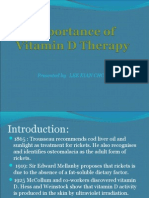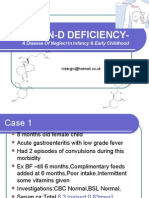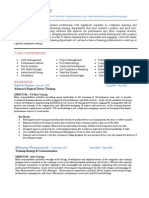Introduction To Vitamin D
Introduction To Vitamin D
Uploaded by
aboelsoud mohamedCopyright:
Available Formats
Introduction To Vitamin D
Introduction To Vitamin D
Uploaded by
aboelsoud mohamedOriginal Description:
Original Title
Copyright
Available Formats
Share this document
Did you find this document useful?
Is this content inappropriate?
Copyright:
Available Formats
Introduction To Vitamin D
Introduction To Vitamin D
Uploaded by
aboelsoud mohamedCopyright:
Available Formats
Vitamin D: introduction
Vitamin D is a fat-soluble vitamin. Very few foods naturally contain vitamin D (fatty fish
livers are the exception), so dermal synthesis is the major natural source of the vitamin.
Vitamin D from the diet or dermal synthesis is biologically inactive and requires enzymatic
conversion to active metabolites. Vitamin D is converted enzymatically in the liver to 25-
hydroxyvitamin D (25[OH]D), the major circulating form of vitamin D, and then in the
kidney to 1,25-dihydroxyvitamin D, the active form of vitamin D.
Vitamin D is well known for its essential role in maintaining healthy bones. Deficiency
causes bones to become soft and weak: a condition known as rickets in children and
osteomalacia in adults. The majority of vitamin D is produced via skin synthesis under the
action of sunlight, with smaller amounts from dietary sources such as oily fish, meat and
eggs. Adequate exposure to ultraviolet (UV) light is therefore necessary to maintain levels.
Other physiological roles of vitamin D in maintaining health are now recognized. Some
evidence suggests that vitamin D deficiency is associated with increased risk of
cardiovascular diseases, some cancers, type 2 diabetes and multiple sclerosis. In addition,
there is also some evidence that low levels are associated with increased risk of all cause
mortality. It is also possible that the relationship is mediated through the association of
vitamin D deficiency with other risk factors, such as lack of physical activity and obesity.
Vitamin D production is in part dependent on skin pigmentation with paler-skinned
individuals able to synthesis vitamin D more efficiently under UV exposure; therefore,
darker-skinned individuals who move to a region experiencing low sunlight are at particular
risk of deficiency.
The Scientific Advisory Committee on Nutrition (2016) recommends that individuals should
have serum concentrations of vitamin D above a ‘population protective level’ of 25 nmol/L
throughout the year. This concentration is considered sufficient to prevent rickets in children
and osteomalacia in adults. Elsewhere, serum concentrations below 50 nmol/L are
considered to be deficient, and higher concentrations such as 75 nmol/L have been
recommended for optimal bone health.
There have been few well-conducted randomized controlled trials of vitamin D
supplementation in healthy adults and those that have been performed have not shown clear
evidence of a benefit from taking supplements. In a recent meta-analysis found that vitamin
D supplementation alone did not reduce cancer incidence or mortality. The potential risks of
excessive sun exposure must also be considered in the context of attempts to increase vitamin
D levels. Clearer evidence is required regarding the health effects, safety and practicality of
increasing population vitamin D levels.
You might also like
- Joseph C. Stemple - Nelson Roy - Bernice Klaben - Clinical Voice Pathology - Theory and Management (2020)Document559 pagesJoseph C. Stemple - Nelson Roy - Bernice Klaben - Clinical Voice Pathology - Theory and Management (2020)mtonciom2702No ratings yet
- MKSAP NotesDocument31 pagesMKSAP NotesJared MasonNo ratings yet
- Overview of Vitamin D - UpToDateDocument18 pagesOverview of Vitamin D - UpToDateleosalesc95No ratings yet
- Overview of Vitamin D Uptodate2015Document5 pagesOverview of Vitamin D Uptodate2015Sheyla Alegre ParionaNo ratings yet
- Vita MindDocument13 pagesVita MindSaid Nafik HkiNo ratings yet
- Vitamin D in Obesity: ReviewDocument6 pagesVitamin D in Obesity: ReviewLorenzo Rondelli LanaNo ratings yet
- Overview of Vitamin DDocument17 pagesOverview of Vitamin DJames Cojab SacalNo ratings yet
- Vitamin D Insufficiency and Deficiency in Children and AdolescentsDocument22 pagesVitamin D Insufficiency and Deficiency in Children and AdolescentsMaría Alejandra PeñaNo ratings yet
- Causes of Vitamin D Deficiency and ResistanceDocument14 pagesCauses of Vitamin D Deficiency and ResistanceSolo GafuNo ratings yet
- Vitamin D Insufficiency: Clinical PracticeDocument7 pagesVitamin D Insufficiency: Clinical PracticeLinta IsnaNo ratings yet
- Vitamin D in Health and Disease A Literature Review. Basit SDocument4 pagesVitamin D in Health and Disease A Literature Review. Basit SaflspyogfNo ratings yet
- Vitamin D: Continuing Education ActivityDocument5 pagesVitamin D: Continuing Education Activityarmelya aisyahNo ratings yet
- Defining Hypovitaminosis DDocument2 pagesDefining Hypovitaminosis DMelissa RosariNo ratings yet
- Actualización Vitamina DDocument8 pagesActualización Vitamina DNatalia AceitunoNo ratings yet
- Vit D Rehab AJPMRDocument8 pagesVit D Rehab AJPMRAtid AmandaNo ratings yet
- Jun-13-SAHM VitaminD Position FinalDocument3 pagesJun-13-SAHM VitaminD Position FinalFrancisca AldunateNo ratings yet
- Vitamin D in Older People: Miles D Witham and Gavin FrancisDocument15 pagesVitamin D in Older People: Miles D Witham and Gavin FrancisIlvita MayasariNo ratings yet
- Sources of Vitamin DDocument5 pagesSources of Vitamin DBimantoro SaputroNo ratings yet
- Prevention of Rickets and Vitamin D Deficiency in Infants, Children, and AdolescentsDocument11 pagesPrevention of Rickets and Vitamin D Deficiency in Infants, Children, and AdolescentsWill TohallinoNo ratings yet
- Vitamin D3 EnglDocument16 pagesVitamin D3 Engltomkuss1No ratings yet
- Vitamin D - Health Professional Fact SheetDocument13 pagesVitamin D - Health Professional Fact SheetTahir AliNo ratings yet
- Prevention of Rickets and Vitamin D Deficiency in Infants, Children, and AdolescentsDocument13 pagesPrevention of Rickets and Vitamin D Deficiency in Infants, Children, and AdolescentsChristianHendrikusSoronganNo ratings yet
- Vitamin D Deficiency in Childhood - A Review of Current Guidelines On Diagnosis and ManagementDocument7 pagesVitamin D Deficiency in Childhood - A Review of Current Guidelines On Diagnosis and Managementcoolarun86No ratings yet
- Vitdarticle IjirasDocument5 pagesVitdarticle IjirasYesenia RizkiNo ratings yet
- Coreten ReferatDocument4 pagesCoreten ReferatjanetaNo ratings yet
- 03 2022 UpToDate Vitamin D Insufficiency and Deficiency in Children and AdolescentsDocument37 pages03 2022 UpToDate Vitamin D Insufficiency and Deficiency in Children and Adolescentssheyla alegreNo ratings yet
- Defisiensi Vitamin DDocument46 pagesDefisiensi Vitamin DFlora RamadhaniNo ratings yet
- 1 Jurnal Vit DDocument11 pages1 Jurnal Vit DDelvia AuroraNo ratings yet
- New Insights About Vitamin D and CV DiseaseDocument8 pagesNew Insights About Vitamin D and CV DiseaseMario LosadaNo ratings yet
- Vitamin DDocument9 pagesVitamin DREINONo ratings yet
- Dr. Ajay H. Kantharia M.D.: Consulting Physician & Cardiologist Critical Care PhysicianDocument38 pagesDr. Ajay H. Kantharia M.D.: Consulting Physician & Cardiologist Critical Care PhysicianChintan ChavdaNo ratings yet
- The Health Effects of Vitamin D Supplementation: Evidence From Human StudiesDocument15 pagesThe Health Effects of Vitamin D Supplementation: Evidence From Human StudiesFathima Nadia FassyNo ratings yet
- Nutrients: Fficiency of Vitamin D Supplementation in HealthyDocument15 pagesNutrients: Fficiency of Vitamin D Supplementation in HealthyLiana MuresanNo ratings yet
- Vitamin D Deficiency: Defining, Prevalence, Causes, and Strategies of AddressingDocument16 pagesVitamin D Deficiency: Defining, Prevalence, Causes, and Strategies of AddressingpuffypalfiNo ratings yet
- 4612 4621 Vitamin D Supplementation For Osteoporosis in Older AdultsDocument10 pages4612 4621 Vitamin D Supplementation For Osteoporosis in Older AdultsMohammedNo ratings yet
- Vitamin D Deficiency and SuicideDocument9 pagesVitamin D Deficiency and Suicidee.mailsnotforsaleNo ratings yet
- Vitamin D Deficiency and Its Repletion A Review 2167 7921.1000105Document11 pagesVitamin D Deficiency and Its Repletion A Review 2167 7921.1000105octusNo ratings yet
- Biomedicines 11 01542 v3Document26 pagesBiomedicines 11 01542 v3cours3bioNo ratings yet
- Vitamin D ThesisDocument5 pagesVitamin D ThesisFelicia Clark100% (2)
- Vitamin D The Sunshine VitaminDocument10 pagesVitamin D The Sunshine VitaminNesti untariNo ratings yet
- Vitamin D Deficiency in Adults - Definition, Clinical Manifestations, and Treatment - UpToDate PDFDocument26 pagesVitamin D Deficiency in Adults - Definition, Clinical Manifestations, and Treatment - UpToDate PDFhidayat0781No ratings yet
- Lesson 8 - Vitamin D and Health - The Missing Vitamin in Humans - pp.1-3Document3 pagesLesson 8 - Vitamin D and Health - The Missing Vitamin in Humans - pp.1-3Cláudia FranzãoNo ratings yet
- Vitamin DDocument9 pagesVitamin DcloogisNo ratings yet
- Vitamin D Brochure FINALDocument3 pagesVitamin D Brochure FINALcommanderkeenNo ratings yet
- Non Classical Research On Vitamin D PresentationDocument13 pagesNon Classical Research On Vitamin D PresentationJoshua AfolabiNo ratings yet
- SummaryDocument3 pagesSummaryJoshua AfolabiNo ratings yet
- Vitamin D ReviewDocument10 pagesVitamin D ReviewAnonymous 1O52sGyNo ratings yet
- Vitamin D Deficiency: An Important, Common, and Easily Treatable Cardiovascular Risk Factor?Document8 pagesVitamin D Deficiency: An Important, Common, and Easily Treatable Cardiovascular Risk Factor?Jauhar FirdausNo ratings yet
- Importance of Vitamin D TherapyDocument22 pagesImportance of Vitamin D Therapyfarmasi_hmNo ratings yet
- Hypovitaminosis D in Adult - A Systemic ReviewDocument8 pagesHypovitaminosis D in Adult - A Systemic ReviewWahab KhaniNo ratings yet
- Use of Vitamin D in Clinical Practice: Review ArticleDocument15 pagesUse of Vitamin D in Clinical Practice: Review ArticleWill TohallinoNo ratings yet
- Vitamin D in Newborn and Preterm Infants: Understanding The Roles, Forms, Metabolism, and Clinical ImplicationsDocument3 pagesVitamin D in Newborn and Preterm Infants: Understanding The Roles, Forms, Metabolism, and Clinical Implicationsnoeldtan.neoNo ratings yet
- Vitamin D PPT Final 1Document53 pagesVitamin D PPT Final 1NisargNo ratings yet
- Vitamin DDocument72 pagesVitamin Dhesham33usNo ratings yet
- Vitamin D PDFDocument23 pagesVitamin D PDFBroo RoorNo ratings yet
- Baking Update Special Edition March 2011 Vitamin D The RevolutionDocument2 pagesBaking Update Special Edition March 2011 Vitamin D The RevolutionJavier GuerreroNo ratings yet
- Vitamin D - Values For Normal Are Exaggerated March 2011Document4 pagesVitamin D - Values For Normal Are Exaggerated March 2011JamesMyersNo ratings yet
- Use of Vitamin D in Clinical Practice: Review ArticleDocument15 pagesUse of Vitamin D in Clinical Practice: Review ArticleBimantoro SaputroNo ratings yet
- The Critical Role of Vitamin D in Infants, Children and AdolescentsDocument69 pagesThe Critical Role of Vitamin D in Infants, Children and AdolescentsRose Ann BunyeNo ratings yet
- Vitamin D Secrets: How To Determine If You Are Vitamin D Deficient And How To Easily Overcome ItFrom EverandVitamin D Secrets: How To Determine If You Are Vitamin D Deficient And How To Easily Overcome ItNo ratings yet
- Fixapret Resin F-ECODocument8 pagesFixapret Resin F-ECOSajida HafeezNo ratings yet
- Sales Training Development in MA CA Resume Frank EstradaDocument2 pagesSales Training Development in MA CA Resume Frank EstradaFrankEstradaNo ratings yet
- Therapeutic Uses and Action of Neem On Skin Diseases Vs InnoVision Neem Capsule/tabletDocument5 pagesTherapeutic Uses and Action of Neem On Skin Diseases Vs InnoVision Neem Capsule/tabletEditor IJIRMFNo ratings yet
- NURS FPX 6026 Assessment 1 Analysis of Position Papers For Vulnerable PopulationsDocument6 pagesNURS FPX 6026 Assessment 1 Analysis of Position Papers For Vulnerable Populationszadem5266No ratings yet
- Epidemiology of Leukemia in Saudi ArabiaDocument19 pagesEpidemiology of Leukemia in Saudi ArabiaFaisal Al-SugairNo ratings yet
- DAY Date: Observation ReportDocument30 pagesDAY Date: Observation ReportPadma priyaNo ratings yet
- Ames Test PDFDocument5 pagesAmes Test PDFRohitNo ratings yet
- RomJOphthalmol 61 90Document5 pagesRomJOphthalmol 61 90Maria MiripNo ratings yet
- Turmeric ResearchDocument38 pagesTurmeric ResearchreyzNo ratings yet
- Cigna TTK Pro Health Insurance ProspectusDocument18 pagesCigna TTK Pro Health Insurance ProspectusChrissy CattonNo ratings yet
- Ewh Ix PDFDocument80 pagesEwh Ix PDFOR Premium FreeNo ratings yet
- Imaging of Intrapulmonary Teratoma - Rizki Yuda PurnomoDocument19 pagesImaging of Intrapulmonary Teratoma - Rizki Yuda Purnomorizki yuda purnomoNo ratings yet
- Interferon 1Document2 pagesInterferon 1assignment2012No ratings yet
- PATHOGNOMONIC SIGN Is Widely Used in The Field of Medicine For It Gives The Doctors A Hint of The Disease Condition The Client Is ExperiencingDocument3 pagesPATHOGNOMONIC SIGN Is Widely Used in The Field of Medicine For It Gives The Doctors A Hint of The Disease Condition The Client Is ExperiencingTammy Tam100% (1)
- Dheeraj DumirDocument11 pagesDheeraj DumirAnonymous CR8v7xb0No ratings yet
- @MBS - MedicalBooksStore 2018 Evidence-Based Endocrine Surgery PDFDocument470 pages@MBS - MedicalBooksStore 2018 Evidence-Based Endocrine Surgery PDFRicardo Uzcategui Arregui100% (2)
- NCP For Acute Lymphocytic LeukemiaDocument7 pagesNCP For Acute Lymphocytic LeukemiaLilian Linogao100% (10)
- 3book ChaptersupratentorialbraintumorsinchildrenDocument13 pages3book ChaptersupratentorialbraintumorsinchildrenLuciano AlvesNo ratings yet
- RadiobiologieDocument129 pagesRadiobiologieEvelyn BodaNo ratings yet
- Norton Healthcare News: January 2008Document12 pagesNorton Healthcare News: January 2008Norton HealthcareNo ratings yet
- 236 - Spectral Karyotyping of The Human Colon Cancer Cell Lines SW480 and SW620Document8 pages236 - Spectral Karyotyping of The Human Colon Cancer Cell Lines SW480 and SW620Fran MoyaNo ratings yet
- Anesthesia CPT and Icd 9 CodesDocument36 pagesAnesthesia CPT and Icd 9 CodesSundarajan ManiNo ratings yet
- Evaluation of Mammography Screening For Early Detection of Breast Cancer Among Women Attending St. Paul's Hospital, Addis Ababa (2023)Document13 pagesEvaluation of Mammography Screening For Early Detection of Breast Cancer Among Women Attending St. Paul's Hospital, Addis Ababa (2023)Duol Dak MaluelNo ratings yet
- Testicular Cancer InformationDocument18 pagesTesticular Cancer InformationDavid IbanezNo ratings yet
- Biopty-Cut - Needle Instructions PDFDocument76 pagesBiopty-Cut - Needle Instructions PDFjohnalanNo ratings yet
- Targeting Hypoxia in The Tumor Microenvironment ADocument16 pagesTargeting Hypoxia in The Tumor Microenvironment AViviana OrellanaNo ratings yet
- What Is HyperglycemiaDocument7 pagesWhat Is HyperglycemiaFelisa Lacsamana GregorioNo ratings yet
- Bower Et Al., J. Surg. Oncol., 104 (1) 22-28, July 2011Document7 pagesBower Et Al., J. Surg. Oncol., 104 (1) 22-28, July 2011CosminaNo ratings yet

























































































